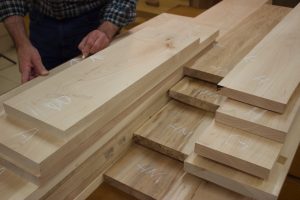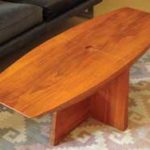We may receive a commission when you use our affiliate links. However, this does not impact our recommendations.
At the end of the workday, what you do with your partially-assembled projects, parts and pieces will determine how quickly and accurately you can get started the next time you get back to the shop. The longer you have to be away from your shop, the more difficult it can be to get started again.
The subject came up during our recent series of classes exploring the use of 5S manufacturing principles as applied to the woodworking shop, and it was answered quite well by a participant. He advised: “Always leave everything so you can remember where you were.”
Since one of the core benefits of 5S (Sort, Set In Order, Shine, Standardize, Sustain) is saving time, his advice is spot-on. You don’t want to waste your precious shop time trying to figure out what to do next, what step you were on, or what you did last.
Will you look at that stack of boards a week from now and remember which ones have been through the planer? Will you know which edges were jointed? Will you remember the last grit you used sanding your latest masterpiece? One time, after traveling for a couple of weeks, I finally got back in my shop and picked up a box I thought was glued up, only to find out (the hard way) it was only dry-assembled.
Significant “start-up” time will be saved with just a little end-of-day diligence, some sticky notes, and a piece of chalk. “Sanded 100 grit” on a sticky note will get you started on the next phase of sanding without hesitation. A chalk arrow pointing to the jointed edge on every board will save time. Labeled parts prevent head scratching. No need trying to remember which piece is a stretcher, which is a drawer runner, and which is going to be a door rail; your notes and chalk marks will remind you.
In addition to notes and labels, a little physical organization will save time, too… especially if you have several different projects underway. Some woods in their raw state can look very similar, and if you find out you mixed in a piece of birch with a batch of maple parts, you might not realize it until you start to apply a finish. Avoid that hassle by grouping projects and parts together at the end of the day.
If you have to stop working in the middle of ripping parts to size, milling edges at the router table, or thickness planing a batch of parts, the machine set-up is already dialed-in and perfect. Don’t risk a change. I like to throw a machine cover, tarp, or blanket over the machine as a gentle caution to guests, “Hands off” and a self reminder, “Don’t change anything; this machine is all set up!”
If you have to leave your shop for a day, a week, or longer, avoid wasting time figuring out where to start when you finally get back to work. Five minutes of shop organization and labeling at the end of the day could save you an hour or more later. Give yourself a “fast start” to your next shop day.
Here are some supplies and tools we find essential in our everyday work around the shop. We may receive a commission from sales referred by our links; however, we have carefully selected these products for their usefulness and quality.











